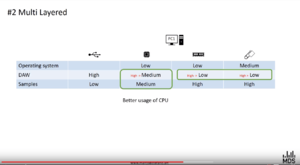HarmonyCore
Senior Member
Hey Everyone,
I watched some YT videos talking about different methods to organize your DAW template. One of the methods used VEPRO (Vienna Ensemble PRO) in order to create instances where each instance hosts many MIDI channels (up to some crazy number). Each channel is connected to a Kontakt instrument. Then, in your DAW, you add instrument tracks so you can connect them to their respective channel in VEPRO. I still don't understand how this method saves more memory than loading Kontakt instruments directly in your DAW. Note that VEPRO is hosted on the same machine, not a networked slave. VEPRO is mainly designed to work over a networked machines so you can connect from your master machine to the slave machine that hosts all the libraries. However, in this video, VEPRO is on the same machine, that's why I don't understand what's the benefit.
Another method is to load Kontakt instruments directly in your template but disable tracks when not used. I am currently having 32 GB RAM and it can run up to 70 enabled tracks at the same time. If I turn off some unneeded background tasks, I can free more 2 GB.
Final method is to add just a few tracks and rely on expression maps or key switches to manage articulations instead of loading each articulation on its own track and that's the main reason why your track count grows in the template.
I don't know what is the best method as I don't have VEPRO. I am just using the second method (up to 70) tracks and that's enough for me at the moment.
Can anyone confirm if the VEPRO method has a lighter RAM footprint?
I watched some YT videos talking about different methods to organize your DAW template. One of the methods used VEPRO (Vienna Ensemble PRO) in order to create instances where each instance hosts many MIDI channels (up to some crazy number). Each channel is connected to a Kontakt instrument. Then, in your DAW, you add instrument tracks so you can connect them to their respective channel in VEPRO. I still don't understand how this method saves more memory than loading Kontakt instruments directly in your DAW. Note that VEPRO is hosted on the same machine, not a networked slave. VEPRO is mainly designed to work over a networked machines so you can connect from your master machine to the slave machine that hosts all the libraries. However, in this video, VEPRO is on the same machine, that's why I don't understand what's the benefit.
Another method is to load Kontakt instruments directly in your template but disable tracks when not used. I am currently having 32 GB RAM and it can run up to 70 enabled tracks at the same time. If I turn off some unneeded background tasks, I can free more 2 GB.
Final method is to add just a few tracks and rely on expression maps or key switches to manage articulations instead of loading each articulation on its own track and that's the main reason why your track count grows in the template.
I don't know what is the best method as I don't have VEPRO. I am just using the second method (up to 70) tracks and that's enough for me at the moment.
Can anyone confirm if the VEPRO method has a lighter RAM footprint?





